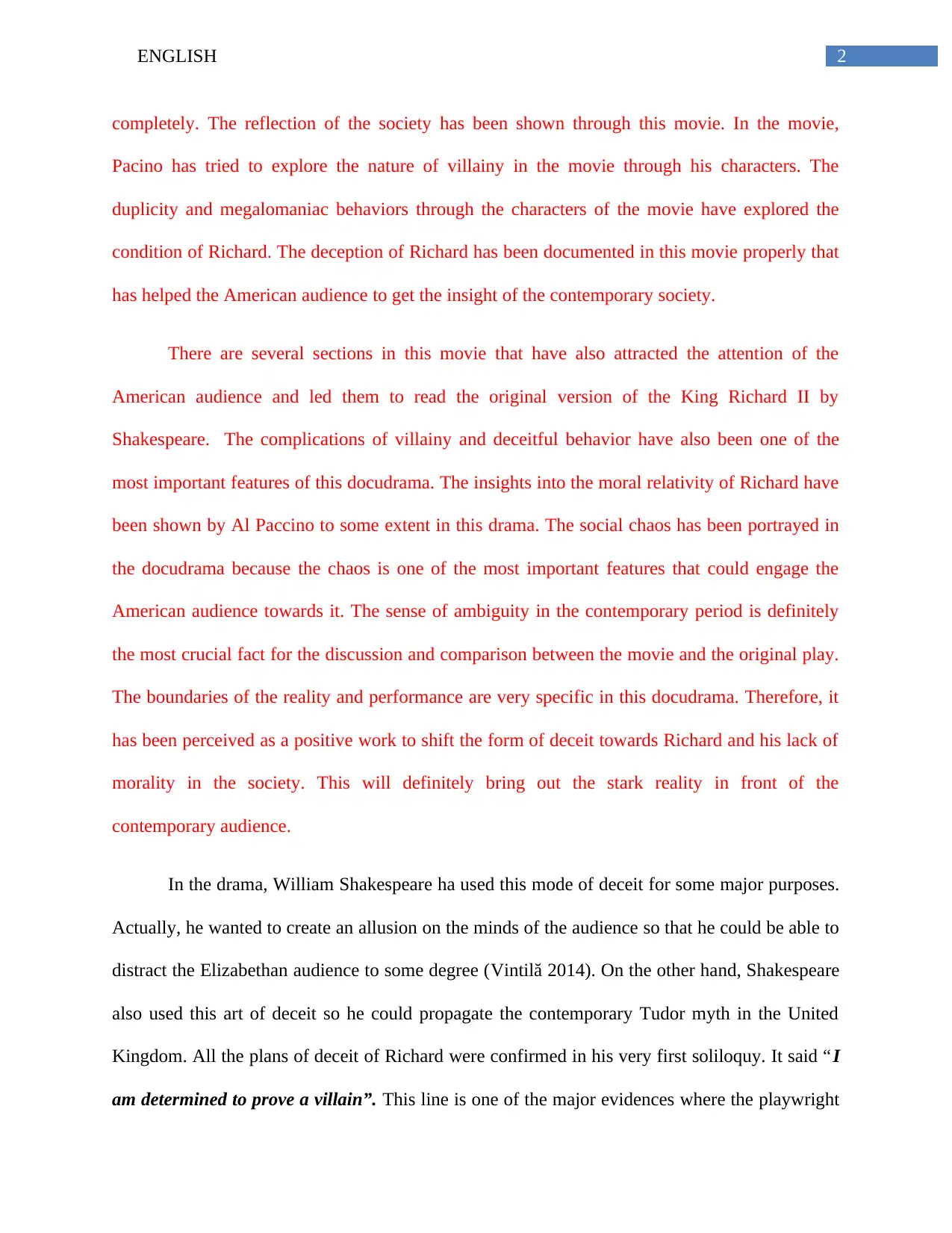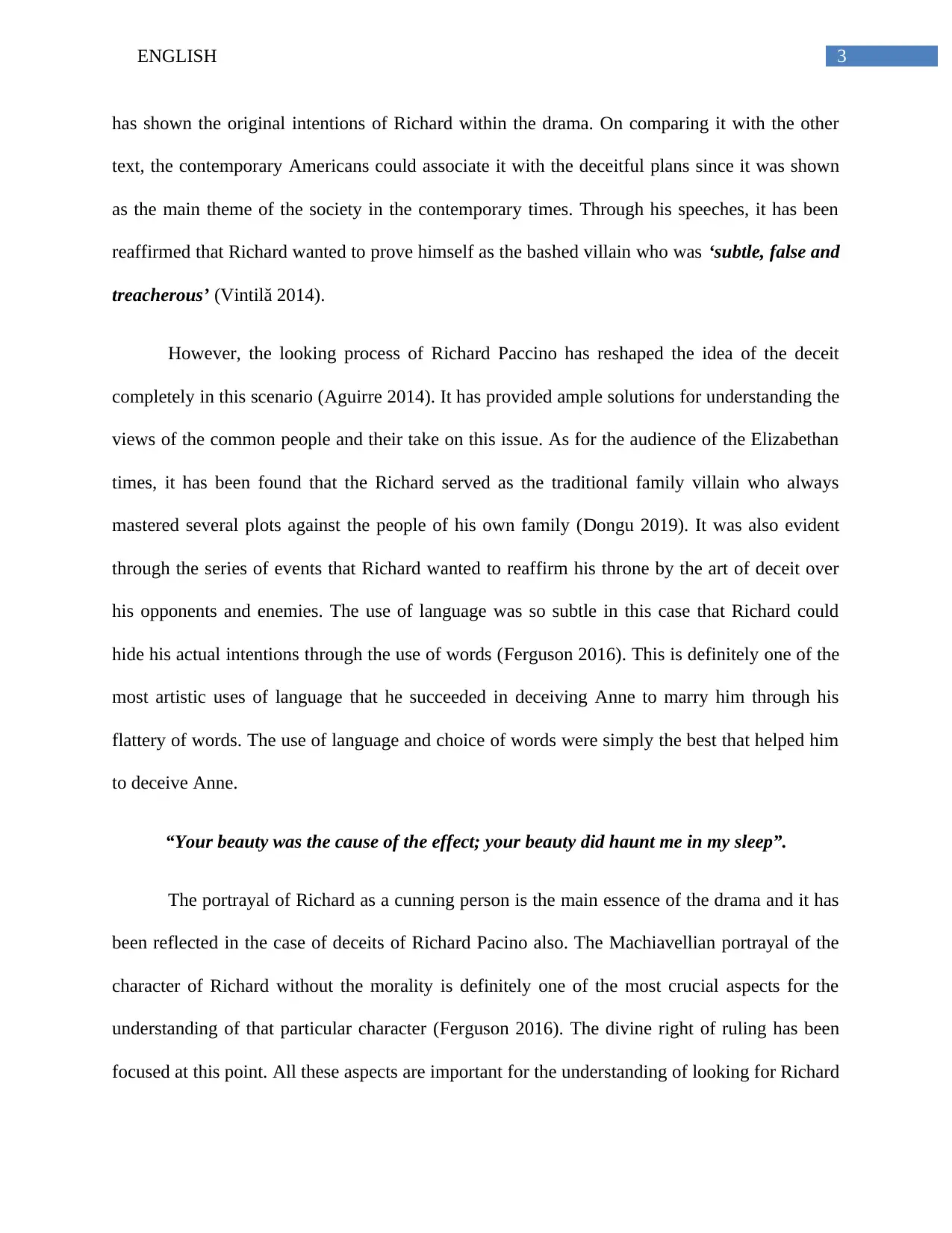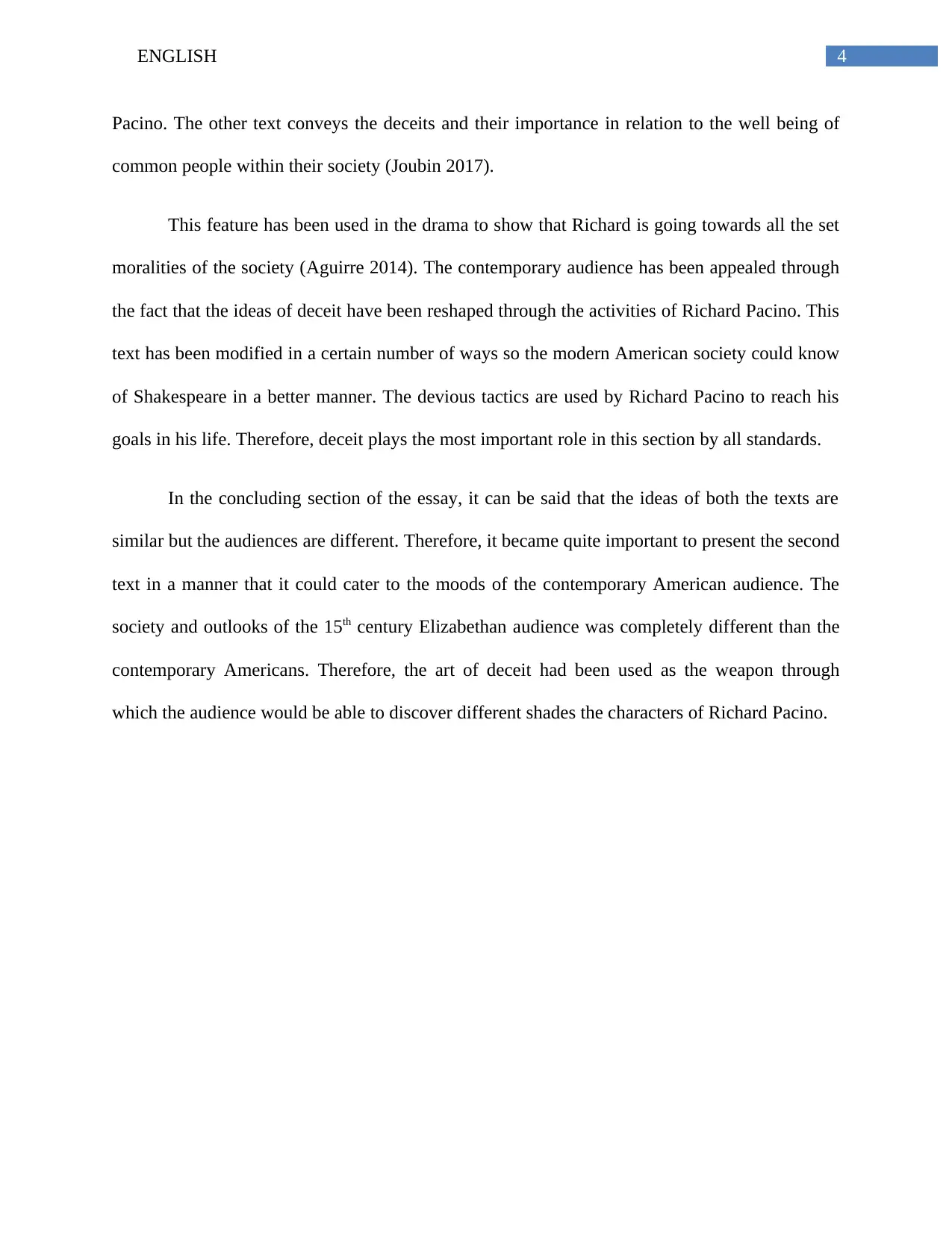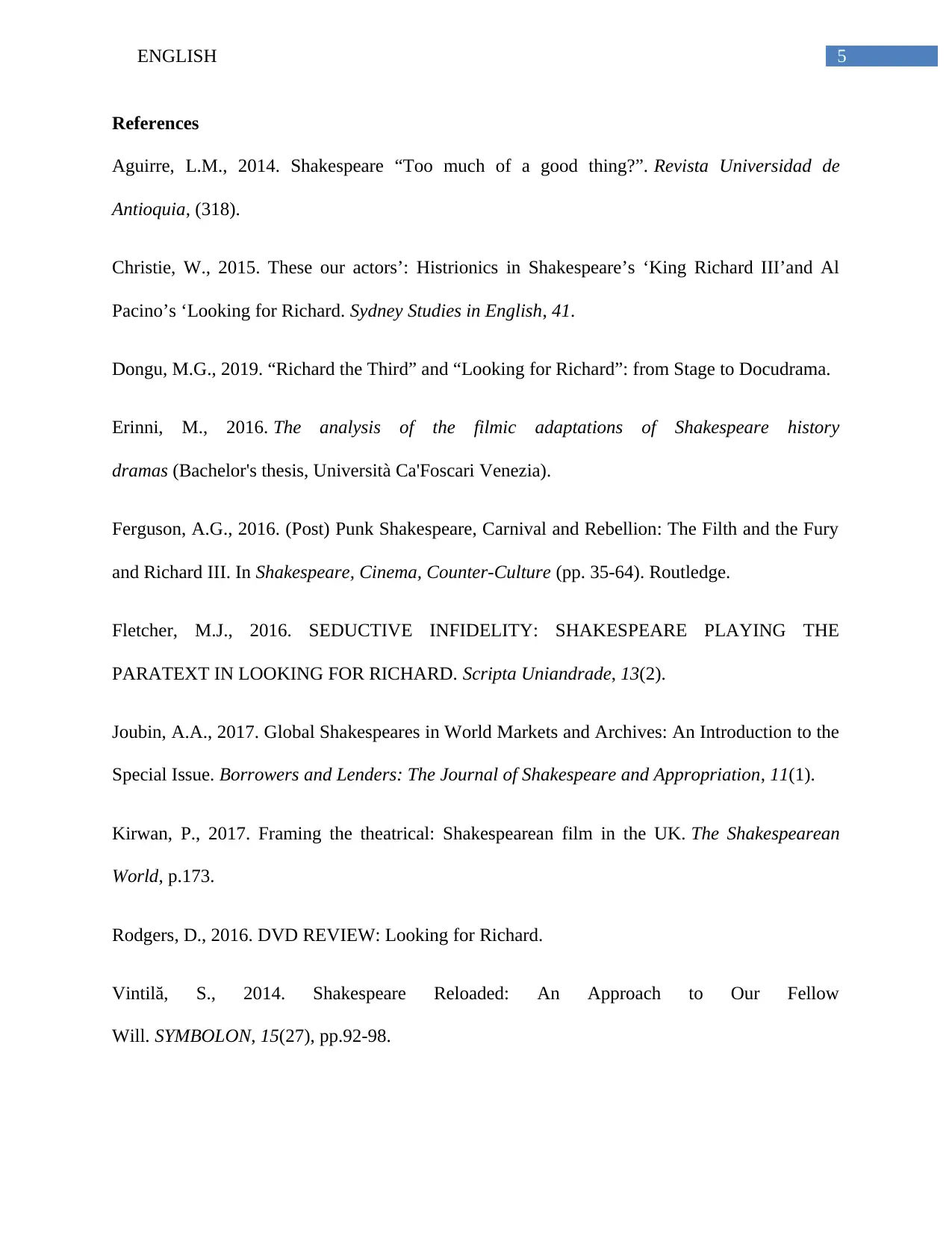Exploring Deceit and Context in Richard III and 'Looking for Richard'
VerifiedAdded on 2022/08/28
|6
|1661
|37
Essay
AI Summary
This essay analyzes the theme of deceit in William Shakespeare's Richard III, examining how it is presented in both the play and Al Pacino's film adaptation, "Looking for Richard." The essay explores the contextual evidence, including scenes and acts, to understand the motivations and outcomes of deceit within the narrative. It discusses the characters' corruption, evil, and unethical behavior, as well as the film's reflection of contemporary society. The essay compares Shakespeare's use of deceit with Pacino's portrayal, highlighting the Machiavellian nature of the character and the impact of language. The essay also explores the themes of social chaos, moral relativity, and the boundaries of reality and performance. The conclusion emphasizes the similarities and differences between the texts, considering the distinct audiences and the role of deceit in reshaping the characters' actions and intentions.

Running head: ENGLISH
English
Name of the Student
Name of the University
Author Note
English
Name of the Student
Name of the University
Author Note
Paraphrase This Document
Need a fresh take? Get an instant paraphrase of this document with our AI Paraphraser

1ENGLISH
Richard III is one of the most notable dramatic works of William Shakespeare. The issues
of deceit and other themes in the drama will be discussed in this essay. The contextual evidence
from the different scenes and acts are indeed very crucial for the understanding of the readers.
The aspect of looking for Richard is very important factor in the overall plot of the drama. It
must be said in this scenario that the idea of deceit has already been seen in the drama and it has
been helpful to address various issues and weaknesses of the plot that can be found in this
scenario (Rodgers 2016). However, some critics have already shown in their arguments that
looking for Richard will provide much insight into the contextual evidence that would help them
to look at the form of deceit in the proper manner. This essay will investigate into the issue of
deceit so the reasons and outcomes of this contextual evidence could be analyzed properly.
Corruption and evil are two of the most important factors that were relevant largely in the
lives of the characters of Richard III. Similarly, this theme had been followed in the film
Looking for Richard also. In this film, the main character was completely sinful and he used the
art of deceit at every step of his life. In the film, Richard has been looked as a completely
unethical person and he has no regard morality whatsoever. Throughout the movie, it had also
been shown that Richard had killed two innocent boys so he could attain the throne. Amidst this
issue, it can be highlighted that Looking for Richard has presented to the American audience a
scope for understanding the deceits that might result in being successful at some point of time.
The postmodern docudrama named Looking for Richard has presented the audience with
all types of opportunities for the American audience. The performances in the scenes of this
docudrama show the essence of the original drama of Shakespeare. In the drama, Shakespeare
had entirely depended on the contemporary society of the Elizabethan period. On the other hand,
Al Paccino has reflected the corruptions and evil mentalities of the contemporary society
Richard III is one of the most notable dramatic works of William Shakespeare. The issues
of deceit and other themes in the drama will be discussed in this essay. The contextual evidence
from the different scenes and acts are indeed very crucial for the understanding of the readers.
The aspect of looking for Richard is very important factor in the overall plot of the drama. It
must be said in this scenario that the idea of deceit has already been seen in the drama and it has
been helpful to address various issues and weaknesses of the plot that can be found in this
scenario (Rodgers 2016). However, some critics have already shown in their arguments that
looking for Richard will provide much insight into the contextual evidence that would help them
to look at the form of deceit in the proper manner. This essay will investigate into the issue of
deceit so the reasons and outcomes of this contextual evidence could be analyzed properly.
Corruption and evil are two of the most important factors that were relevant largely in the
lives of the characters of Richard III. Similarly, this theme had been followed in the film
Looking for Richard also. In this film, the main character was completely sinful and he used the
art of deceit at every step of his life. In the film, Richard has been looked as a completely
unethical person and he has no regard morality whatsoever. Throughout the movie, it had also
been shown that Richard had killed two innocent boys so he could attain the throne. Amidst this
issue, it can be highlighted that Looking for Richard has presented to the American audience a
scope for understanding the deceits that might result in being successful at some point of time.
The postmodern docudrama named Looking for Richard has presented the audience with
all types of opportunities for the American audience. The performances in the scenes of this
docudrama show the essence of the original drama of Shakespeare. In the drama, Shakespeare
had entirely depended on the contemporary society of the Elizabethan period. On the other hand,
Al Paccino has reflected the corruptions and evil mentalities of the contemporary society

2ENGLISH
completely. The reflection of the society has been shown through this movie. In the movie,
Pacino has tried to explore the nature of villainy in the movie through his characters. The
duplicity and megalomaniac behaviors through the characters of the movie have explored the
condition of Richard. The deception of Richard has been documented in this movie properly that
has helped the American audience to get the insight of the contemporary society.
There are several sections in this movie that have also attracted the attention of the
American audience and led them to read the original version of the King Richard II by
Shakespeare. The complications of villainy and deceitful behavior have also been one of the
most important features of this docudrama. The insights into the moral relativity of Richard have
been shown by Al Paccino to some extent in this drama. The social chaos has been portrayed in
the docudrama because the chaos is one of the most important features that could engage the
American audience towards it. The sense of ambiguity in the contemporary period is definitely
the most crucial fact for the discussion and comparison between the movie and the original play.
The boundaries of the reality and performance are very specific in this docudrama. Therefore, it
has been perceived as a positive work to shift the form of deceit towards Richard and his lack of
morality in the society. This will definitely bring out the stark reality in front of the
contemporary audience.
In the drama, William Shakespeare ha used this mode of deceit for some major purposes.
Actually, he wanted to create an allusion on the minds of the audience so that he could be able to
distract the Elizabethan audience to some degree (Vintilă 2014). On the other hand, Shakespeare
also used this art of deceit so he could propagate the contemporary Tudor myth in the United
Kingdom. All the plans of deceit of Richard were confirmed in his very first soliloquy. It said “I
am determined to prove a villain”. This line is one of the major evidences where the playwright
completely. The reflection of the society has been shown through this movie. In the movie,
Pacino has tried to explore the nature of villainy in the movie through his characters. The
duplicity and megalomaniac behaviors through the characters of the movie have explored the
condition of Richard. The deception of Richard has been documented in this movie properly that
has helped the American audience to get the insight of the contemporary society.
There are several sections in this movie that have also attracted the attention of the
American audience and led them to read the original version of the King Richard II by
Shakespeare. The complications of villainy and deceitful behavior have also been one of the
most important features of this docudrama. The insights into the moral relativity of Richard have
been shown by Al Paccino to some extent in this drama. The social chaos has been portrayed in
the docudrama because the chaos is one of the most important features that could engage the
American audience towards it. The sense of ambiguity in the contemporary period is definitely
the most crucial fact for the discussion and comparison between the movie and the original play.
The boundaries of the reality and performance are very specific in this docudrama. Therefore, it
has been perceived as a positive work to shift the form of deceit towards Richard and his lack of
morality in the society. This will definitely bring out the stark reality in front of the
contemporary audience.
In the drama, William Shakespeare ha used this mode of deceit for some major purposes.
Actually, he wanted to create an allusion on the minds of the audience so that he could be able to
distract the Elizabethan audience to some degree (Vintilă 2014). On the other hand, Shakespeare
also used this art of deceit so he could propagate the contemporary Tudor myth in the United
Kingdom. All the plans of deceit of Richard were confirmed in his very first soliloquy. It said “I
am determined to prove a villain”. This line is one of the major evidences where the playwright
⊘ This is a preview!⊘
Do you want full access?
Subscribe today to unlock all pages.

Trusted by 1+ million students worldwide

3ENGLISH
has shown the original intentions of Richard within the drama. On comparing it with the other
text, the contemporary Americans could associate it with the deceitful plans since it was shown
as the main theme of the society in the contemporary times. Through his speeches, it has been
reaffirmed that Richard wanted to prove himself as the bashed villain who was ‘subtle, false and
treacherous’ (Vintilă 2014).
However, the looking process of Richard Paccino has reshaped the idea of the deceit
completely in this scenario (Aguirre 2014). It has provided ample solutions for understanding the
views of the common people and their take on this issue. As for the audience of the Elizabethan
times, it has been found that the Richard served as the traditional family villain who always
mastered several plots against the people of his own family (Dongu 2019). It was also evident
through the series of events that Richard wanted to reaffirm his throne by the art of deceit over
his opponents and enemies. The use of language was so subtle in this case that Richard could
hide his actual intentions through the use of words (Ferguson 2016). This is definitely one of the
most artistic uses of language that he succeeded in deceiving Anne to marry him through his
flattery of words. The use of language and choice of words were simply the best that helped him
to deceive Anne.
“Your beauty was the cause of the effect; your beauty did haunt me in my sleep”.
The portrayal of Richard as a cunning person is the main essence of the drama and it has
been reflected in the case of deceits of Richard Pacino also. The Machiavellian portrayal of the
character of Richard without the morality is definitely one of the most crucial aspects for the
understanding of that particular character (Ferguson 2016). The divine right of ruling has been
focused at this point. All these aspects are important for the understanding of looking for Richard
has shown the original intentions of Richard within the drama. On comparing it with the other
text, the contemporary Americans could associate it with the deceitful plans since it was shown
as the main theme of the society in the contemporary times. Through his speeches, it has been
reaffirmed that Richard wanted to prove himself as the bashed villain who was ‘subtle, false and
treacherous’ (Vintilă 2014).
However, the looking process of Richard Paccino has reshaped the idea of the deceit
completely in this scenario (Aguirre 2014). It has provided ample solutions for understanding the
views of the common people and their take on this issue. As for the audience of the Elizabethan
times, it has been found that the Richard served as the traditional family villain who always
mastered several plots against the people of his own family (Dongu 2019). It was also evident
through the series of events that Richard wanted to reaffirm his throne by the art of deceit over
his opponents and enemies. The use of language was so subtle in this case that Richard could
hide his actual intentions through the use of words (Ferguson 2016). This is definitely one of the
most artistic uses of language that he succeeded in deceiving Anne to marry him through his
flattery of words. The use of language and choice of words were simply the best that helped him
to deceive Anne.
“Your beauty was the cause of the effect; your beauty did haunt me in my sleep”.
The portrayal of Richard as a cunning person is the main essence of the drama and it has
been reflected in the case of deceits of Richard Pacino also. The Machiavellian portrayal of the
character of Richard without the morality is definitely one of the most crucial aspects for the
understanding of that particular character (Ferguson 2016). The divine right of ruling has been
focused at this point. All these aspects are important for the understanding of looking for Richard
Paraphrase This Document
Need a fresh take? Get an instant paraphrase of this document with our AI Paraphraser

4ENGLISH
Pacino. The other text conveys the deceits and their importance in relation to the well being of
common people within their society (Joubin 2017).
This feature has been used in the drama to show that Richard is going towards all the set
moralities of the society (Aguirre 2014). The contemporary audience has been appealed through
the fact that the ideas of deceit have been reshaped through the activities of Richard Pacino. This
text has been modified in a certain number of ways so the modern American society could know
of Shakespeare in a better manner. The devious tactics are used by Richard Pacino to reach his
goals in his life. Therefore, deceit plays the most important role in this section by all standards.
In the concluding section of the essay, it can be said that the ideas of both the texts are
similar but the audiences are different. Therefore, it became quite important to present the second
text in a manner that it could cater to the moods of the contemporary American audience. The
society and outlooks of the 15th century Elizabethan audience was completely different than the
contemporary Americans. Therefore, the art of deceit had been used as the weapon through
which the audience would be able to discover different shades the characters of Richard Pacino.
Pacino. The other text conveys the deceits and their importance in relation to the well being of
common people within their society (Joubin 2017).
This feature has been used in the drama to show that Richard is going towards all the set
moralities of the society (Aguirre 2014). The contemporary audience has been appealed through
the fact that the ideas of deceit have been reshaped through the activities of Richard Pacino. This
text has been modified in a certain number of ways so the modern American society could know
of Shakespeare in a better manner. The devious tactics are used by Richard Pacino to reach his
goals in his life. Therefore, deceit plays the most important role in this section by all standards.
In the concluding section of the essay, it can be said that the ideas of both the texts are
similar but the audiences are different. Therefore, it became quite important to present the second
text in a manner that it could cater to the moods of the contemporary American audience. The
society and outlooks of the 15th century Elizabethan audience was completely different than the
contemporary Americans. Therefore, the art of deceit had been used as the weapon through
which the audience would be able to discover different shades the characters of Richard Pacino.

5ENGLISH
References
Aguirre, L.M., 2014. Shakespeare “Too much of a good thing?”. Revista Universidad de
Antioquia, (318).
Christie, W., 2015. These our actors’: Histrionics in Shakespeare’s ‘King Richard III’and Al
Pacino’s ‘Looking for Richard. Sydney Studies in English, 41.
Dongu, M.G., 2019. “Richard the Third” and “Looking for Richard”: from Stage to Docudrama.
Erinni, M., 2016. The analysis of the filmic adaptations of Shakespeare history
dramas (Bachelor's thesis, Università Ca'Foscari Venezia).
Ferguson, A.G., 2016. (Post) Punk Shakespeare, Carnival and Rebellion: The Filth and the Fury
and Richard III. In Shakespeare, Cinema, Counter-Culture (pp. 35-64). Routledge.
Fletcher, M.J., 2016. SEDUCTIVE INFIDELITY: SHAKESPEARE PLAYING THE
PARATEXT IN LOOKING FOR RICHARD. Scripta Uniandrade, 13(2).
Joubin, A.A., 2017. Global Shakespeares in World Markets and Archives: An Introduction to the
Special Issue. Borrowers and Lenders: The Journal of Shakespeare and Appropriation, 11(1).
Kirwan, P., 2017. Framing the theatrical: Shakespearean film in the UK. The Shakespearean
World, p.173.
Rodgers, D., 2016. DVD REVIEW: Looking for Richard.
Vintilă, S., 2014. Shakespeare Reloaded: An Approach to Our Fellow
Will. SYMBOLON, 15(27), pp.92-98.
References
Aguirre, L.M., 2014. Shakespeare “Too much of a good thing?”. Revista Universidad de
Antioquia, (318).
Christie, W., 2015. These our actors’: Histrionics in Shakespeare’s ‘King Richard III’and Al
Pacino’s ‘Looking for Richard. Sydney Studies in English, 41.
Dongu, M.G., 2019. “Richard the Third” and “Looking for Richard”: from Stage to Docudrama.
Erinni, M., 2016. The analysis of the filmic adaptations of Shakespeare history
dramas (Bachelor's thesis, Università Ca'Foscari Venezia).
Ferguson, A.G., 2016. (Post) Punk Shakespeare, Carnival and Rebellion: The Filth and the Fury
and Richard III. In Shakespeare, Cinema, Counter-Culture (pp. 35-64). Routledge.
Fletcher, M.J., 2016. SEDUCTIVE INFIDELITY: SHAKESPEARE PLAYING THE
PARATEXT IN LOOKING FOR RICHARD. Scripta Uniandrade, 13(2).
Joubin, A.A., 2017. Global Shakespeares in World Markets and Archives: An Introduction to the
Special Issue. Borrowers and Lenders: The Journal of Shakespeare and Appropriation, 11(1).
Kirwan, P., 2017. Framing the theatrical: Shakespearean film in the UK. The Shakespearean
World, p.173.
Rodgers, D., 2016. DVD REVIEW: Looking for Richard.
Vintilă, S., 2014. Shakespeare Reloaded: An Approach to Our Fellow
Will. SYMBOLON, 15(27), pp.92-98.
⊘ This is a preview!⊘
Do you want full access?
Subscribe today to unlock all pages.

Trusted by 1+ million students worldwide
1 out of 6
Your All-in-One AI-Powered Toolkit for Academic Success.
+13062052269
info@desklib.com
Available 24*7 on WhatsApp / Email
![[object Object]](/_next/static/media/star-bottom.7253800d.svg)
Unlock your academic potential
Copyright © 2020–2025 A2Z Services. All Rights Reserved. Developed and managed by ZUCOL.

